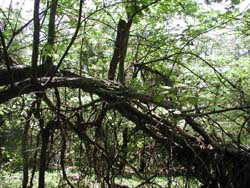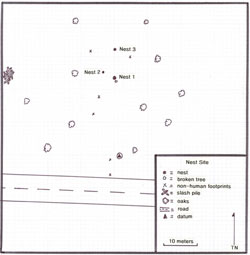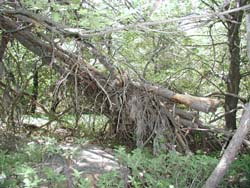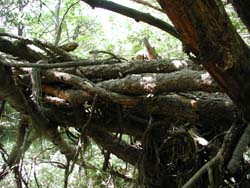
|
||||||||||||||||||
|
|
||||||||||||||||||
|
| ||||||||||||||||||
  






  








| ||||||||||||||||||
An Analysis of an Alleged Sasquatch Nest

Figure 2 - A roofed nest |
INTRODUCTION
On May 13, 2001, three unusual structures constructed of natural materials were located above Sonora, California. Due to their size, shape, construction, and association with recently purported Sasquatch activity, these structures may be related to the occupation of an unknown hominid in the area.
Although two of the nests were incomplete and unused, the third nest was well constructed and appeared to have been recently used. Since there has not been a complete and thorough recordation of reported Sasquatch nests, this article will analyze construction and bedding methods and materials.
NATURAL ENVIRONMENT
The alleged Sasquatch nests are located on private land, above Sonora, California. Although the nests themselves are situated at an elevation of 3800 ft. a.s.l., the area ranges from 2000 to over 4000 feet. The vegetation consists of a Pine/Oak forest, including Black Oak (Quercus kelloggii), Interior Live Oak (Quercus wislizenii), Jeffery Pine (Pinus jeffreyi), manzanita (Arctostaphylos viscida), and Bracken fern (Pteridium aquilinum).
Water in the area is plentiful. An unnamed tributary of the Stanislaus River is located within 100 feet of the location. An historic gold mining ditch, built in the 1850s to carry water to the town of Sonora, is located ? of a mile away. The ditch, built on the gentle mid-slope of hillsides, provides a level, easy walking path from Strawberry, California to Sonora. Beside fish located in both the stream and ditch, the Sonora Deer Herd, consisting of 300+ animals, utilizes the area. Numerous abandoned mines also dot the landscape. There are no previously identified prehistoric, proto-historic, or ethnographic Native American sites in the area (U.S.D.A. Forest Service). There are no known recreational uses of the area.
RESEARCH BACKGROUND
Several types of Sasquatch sleeping or resting locations are described in Bindernagel (1988:68-71). These include beds, nests (both roofed and unroofed), and dens. Nests are defined as constructed structures, usually consisting of sticks and/or branches with a soft lining (usually moss). Several examples are given from various places, including a nest from southern Oregon that was lined with fern fronds (Bindernagel 1988:69). Several fir trees located adjacent to the nest had their tops snapped off, seven feet up. The nest was described as ?soft, springy, and well-engineered? (Bindernagel 1988:69). A second nest found in British Columbia had branches woven in and around the outside of the nest.
Bindernagel (1988:69) also describes a partial-roof nest from Knight Inlet. This nest was discovered by a professor doing research on bears and found the Sasquatch ?bower?, consisting of bent, broken, and over-arching branches.
Krantz (1992:138-139) also noted a bedding site in the Blue Mountains, only fifty yards from a gravel road. The bed consisted of broken branches laid out in a layer, eight feet long by four feet wide. The bed was found nearby recent tracks and broken top trees (Krantz 1992:138).
The best-described sleeping location can be attributed to Dr. Henner Fahrenbach. This den was found inside a mine shaft in Oregon and measured ?four feet by four-and-a-half feet, and was oval in outline? (Bindernagel 1988:214). The floor was made of sticks and was covered with about one inch of dry, composted leaves. Fresh greenery was on top of that, for a total of three inches. It appeared as if the bed had been ?intermittently replenished with fresh vegetation? (Bindernagel 1988:70). The vegetation was inventoried extensively and included cedars, maples, alder, ferns, moss, lichens, and mushrooms (Bindernagel 1988:214-215).
As noted in Bindernagel (1988:177-179), gorilla, chimpanzee, bonobo, and orangutan all make and use nests. Many of these nests are similar in description, such as simple weaving by chimpanzees, to reported Sasquatch nests.
RESEARCH METHOD
Site Description
Purported Sasquatch activity was first noted in the area in March 2001. Activities attributed to Sasquatch include dozens of 14? footprints (with a 5.5 foot stride) within the immediate vicinity of the nests; 14 broken or twisted top trees within the immediate area and a quarter-mile radius; vocalizations; and activity at a bait station.
The author and Montra DuMond, BFRO Investigator, located the nests on May 13, 2001, after an hour-old broken top tree was noted along a roadside. Fresh 14? footprints on a trail leading up the side of a hill were also noted.

Figure 1 - Map of site |
A total of three nests were located within 10 meters of each other (Figure 1). Nest One, located 30 meters north of the road, is well constructed. It appears to have been used based on the presence of a matted 213 x 30 cm. ?body? imprint in the nest padding. The nest measures 1.3 meters high, 1.6 meters wide (N/S), and 1.9 meters long (E/W). The doorway into the structure opened to the northwest. It was constructed of Live Oak and Jeffery Pine. A twisted top oak tree, snapped at six feet, is located immediately adjacent to this nest. Nest Two, located 3.6 meters northwest of Nest One, is a simple lean-two type, incomplete, and apparently unused. It measures 1.24 meters high, 0.50 meters wide (N/S), and 0.53 meters long (E/W). Nest Three, located 9.2 meters north of Nest One, consists of a Live Oak tree, bent in a southern direction, and weighted down by a log. No other modifications were noted, and it appeared to have never been used. The nest measured 1.6 meters high, with an undefined width or length.
Because Nests Two and Three were incomplete and apparently unused, the analysis of construction methods and materials will focus only on Nest One.
Field Methods
The area of the find was intensively surveyed on May 13, 2001 for any evidence of past human and Sasquatch activity. Nest One was photographed and measured on that date, however, since the nest appeared to have been recently occupied, it was left alone (but watched) until one month later when it was determined to have been abandoned. On June 9, 2001, that nest was again measured, photographed, and drawn. The interior of the nest was closely examined and then an area consisting of 160 x 190 x 10 cm. (3 square meters) was collected, using a trowel and scoop, in three layers (top, middle, and bottom), placed into plastic bags, and then labeled by location. To prevent any possible contamination, the collector wore rubber gloves and a hair net. The nest was then dismantled to determine construction method.
Laboratory Methods
Each layer of the soil and leaf material from the nest were cataloged (content and material), measured both in weight and volume, and examined visually for any presence of hairs, dung, teeth, bone, blood, and other non-organic material. The layers were then screened through 4.0-mm. and 2.0-mm. mesh screening, sorted using tweezers, and again inspected for the presence of materials. After washing the soil through 35-mm. screen to remove dust particles, approximately 30 percent of soil from the bottom layer was then examined through 10X magnification. Note that there was no soil present in the upper two layers.
RESULTS
Survey
An intensive survey of the area revealed no evidence of human recreational activities. No trash or fire rings were located. Approximately 40 meters west of Nest One, an old slash pile consisting of oak and pine was located. Further survey revealed that the upper end of the property had been cleared several years ago, and this slash pile apparently holds some of the waste from that activity. Evidence of Sasquatch activity is described under the site description.

Figure 3 - Nest One, a roofed nest |
Structure Construction
Based on Bindernagel (1988), Nest One can be considered a roofed nest (Figure 2 and Figure 3). After taking the nest apart, its construction appears to have been made in three stages. First, a twelve-foot Live Oak tree was bent in a southern direction to create a dome. It was secured by a large rock on top of the limb ends. This process did not kill the oak, and fresh green leaves were present on the tree at the time of recording (in fact, after the rock was moved, the tree sprang about half way back to its original height, suggesting the bend was very recent).
Second, 15 seven-foot (on average) Jeffery Pine branches, which were striped of smaller ancillary limbs, were woven into the bent oak branches to create a windbreak on the south end. It appears that the weaving starting from the top of the bend, down toward the bottom. All of the limbs were entered into the windbreak in the same direction, with the smaller ends inserted first, and woven in and out, right to left. Smaller sticks were used to fill in the holes (Figure 4 and Figure 5). The limb ends had been cut with a saw and appear to have come from the slash pile (Figure 6).

Figure 5 - Smaller sticks used to fill holes |
Third, through the western opening, the interior was padded with various vegetation materials. See the section below for details.
Interior Composition
Based on an initial small trench cut into the opening, it was determined that the interior of the nest consisted of three layers. Layer One, located on the surface, measured three cm. thick, and consisted of fresh moss, Bracken fern fronds, and oak leaves. Layer Two, located below Layer One, measured 4 cm. thick, and consisted of mainly dead, decomposing leaves. Layer Three, on the bottom, was 3 cm. thick and was made up of old moss, Bracken Fern fronds, and soil. Overall, the nest had a spongy, soft consistency.
None of the layers had any apparent smell, other than that of dead and decaying organic material. No rocks or sticks were noted.
Layer Examination
As noted above, all the interior layers were examined for the presence of bone, teeth, hairs, blood, or any other non-organic materials. No items that could be associated with Sasquatch were found. The examination of the soil samples under 10X magnification yielded unburned plant materials, seeds, and insects casings.
SUMMARY AND CONCLUSION
Since a Sasquatch was not directly observed either making or using the nest, a direct association cannot be made. However, the nest construction is very similar to those described in Bindernagel (1988) and Krantz (1992). Other purported Sasquatch activity (fresh twisted tree tops and 14? prints, and recent vocalizations) suggests that its is possible a single Sasquatch was in the area of the nest within the time frame that the nest was built.
During the months of March and April 2001, 10 twisted top trees, snapped at six to six ? feet, appeared along a road way the author was using to blast alleged Sasquatch vocalizations and had establish bait stations. On several occasions, new broken trees appeared in the same locations as the blasting occurred the evening before. Once this pattern was established, all night vigils intended to observe this activity inadvertently led to a decreased use of the location. It appears that a human presence (or the blasting) at the first location pushed the activity to the nest location, located approximately ? mile away. A presence at the second location also appears to have led to a decrease in activity.
Based on the single sized footprints and stride, it appears that a lone Sasquatch was occupying the area. Although the area has water, food, and shelter, because it is closer to human occupation, this territory is not likely a choice location. It is very possible that this Sasquatch was new to the area and was occupying it because it was the only territory available. He may very well be a young male that was ?kicked out? of the better territories in the Emigrant Wilderness/Strawberry area.
Bindernagel (1988:179) offers a possible explanation for the construction of nests. He describes something called ?functionally inappropriate? behavior, brought on by tension created from various situations (such as contact with humans, etc.). The twisting off and breaking of branches and saplings ?may be components of nest-building behavior, engaged in outside of their normal context by sasquatches which are fleeing or otherwise tense or fearful? (Bindernagel 1988:179). If the Sasquatch was recently ousted from a better territory, he would no longer have access to ?traditional? sleeping locations. Further, a sleeping area established in the first location (there are at least two known mines in that area, all on private land) may have had to be abandoned due to the presence of the author doing research.
Whatever the reason for the construction of the nests, the evidence presented suggests the possibility of them being constructed and at least briefly occupied by a Sasquatch. Research continues in the area and any new discoveries will be reported.
REFERENCES
- Bindernagel, John A.
- Krantz, Grover S.
- U.S.D.A., U.S. Forest Service
1988. North America?s Great Ape:? the Sasquatch.? Courtenay, B.C.:?Beachcomber Books.
1992. Big Footprints.? A Scientific Inquiry into the Reality of Sasquatch. Boulder: Johnson Printing Company.
n.d. Archaeological atlas. On file at the Supervisor?s Office, Stanislaus National Forest, Sonora, California.
If you would like to contact the BFRO regarding this article, please use our comment form.